5 Tips on How to Write Cold Outreach Emails That Will Get a Response
How to
Oldie but goodie — cold email outreach proved its efficiency as a marketing and SEO tool, and it's still the best way to get those quality and trusted backlinks. Yet, as this tool is old enough to become banal, you need a fresh approach that leaves your recipients clamoring to respond.
We're going beyond the trivial cold email outreach campaign in this blog post. Whether you're an SEO expert or a rookie link builder, these strategies will boost your approach to cold email outreach. They will help you to make a powerful link profile and create an entity of your brand name for Google.
What is Cold Email Outreach?
Cold email outreach campaign is a strategic communication method when you send an email to a potential customer and initiate contact without any prior relationship or connection to generate leads and for networking, or SEO, content specialist, and link building to gather prospects, collaborate and get backlinks.
How to Write a Cold Email? 5 Tips for Cold Emailing
- Understanding Your Recipient Is a Must
- Craft an Attention-Grabbing Subject Line
- Personalization Is Key
- Keep the Email Focused on the Main Goal
- Ignite Action with Precision
- Use a Robust Tech Stack to Create Emailing Lists
Tip 0. Understanding Your Recipient Is a Must
As SEO specialists, we receive the same type of messages through all possible channels. These “high-quality offers” seep into email, LinkedIn, and FB, but answer honestly — how many of them do we open? To stand out in a crowded inbox of other SEO specialists while running cold email outreach campaigns — you need to go beyond the "Hello-Sir-I-have-high-quality sites" tactics.
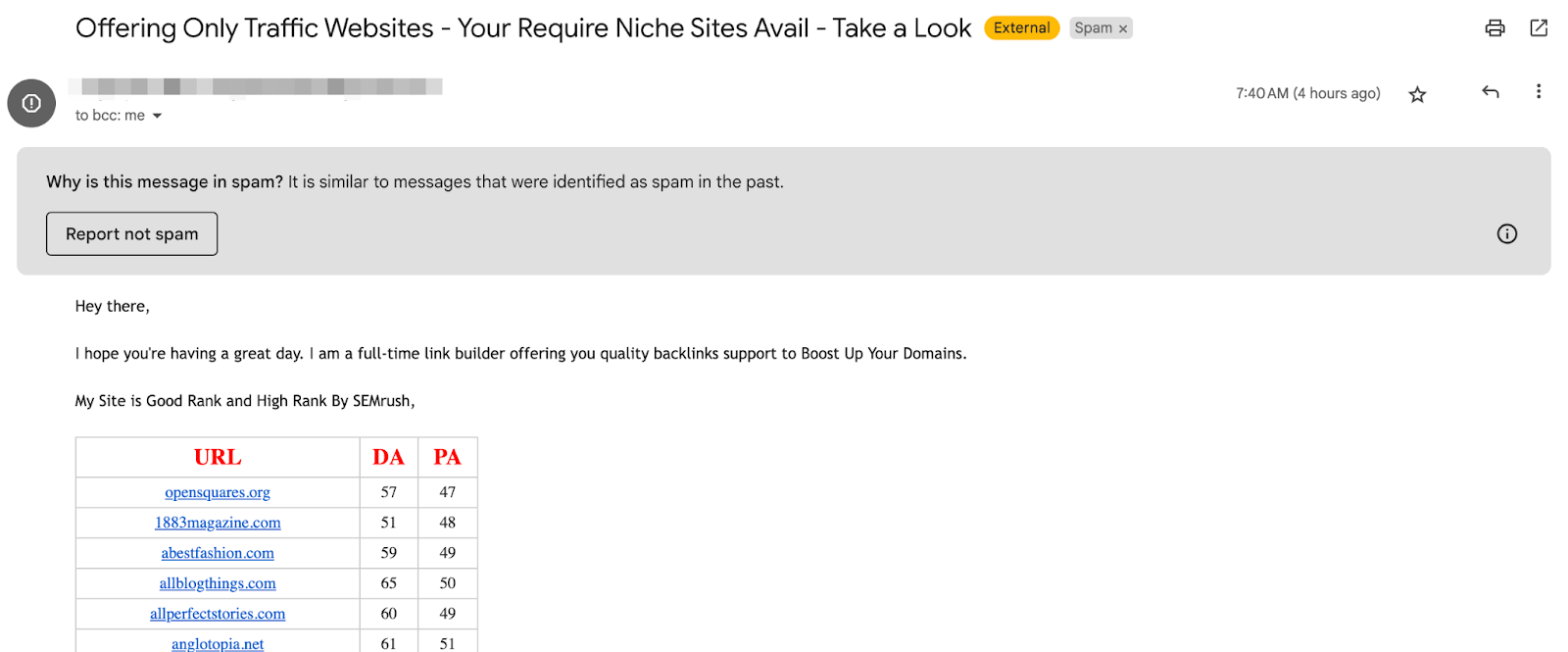
Begin with understanding your audience and create your message to resonate with the recipient's role (e.g., SEO, content creator, marketer) and their challenges. Show genuine interest in their work and provide a value-packed solution that can solve their problem.
In general, these cold emails for link building should be based on the same strategy as cold sales, namely, finding the pain of the target audience. As a SEO specialist, what can you do to gain the prospect’s attention and trusted links? Of course, understand their pain points and provide the solution they’re looking for.
Other SEO specialists and link builders
Reaching out to fellow SEOs and link builders is a great opportunity for collaboration. They are always interested in some more quality and trusted links, so we propose the links to them first.
You can suggest link exchanges (or ABC exchange) and explore alternative options for collaboration. Think outside the box. High-quality links are valuable currency in the SEO world, so you need to avoid boring and generic cold email outreach pitch.
Content teams
When engaging with content teams, it's crucial to write a great cold email that shows a deep understanding of their blog or website. With the E-E-A-T update, they are always seeking expert content supported by statistics and real-life cases.
Take the time to identify their content gaps and propose tailored topics that align with their target audience. When you suggest personalized content ideas, you demonstrate your expertise and build a connection that goes beyond a simple link request.
PR or marketing specialists
To catch the attention of PR specialists or marketers, you need to align your strategies with their goals and initiatives. For example, instead of sending generic cold email outreach pitch, research upcoming events or holidays and propose collaborations that tie into their promotional efforts.
Pitching a product inclusion in Black Friday articles or a joint campaign tied to a National Awareness Day can create a win-win scenario for both of you. Also, marketers will be interested in adding their product to the best tools listing articles, get product review, and increase brand awareness.
Don’t forget:
- In your cold email, explicitly address the pain points you've identified. Offer solutions or opportunities that demonstrate how your collaboration can help with your prospect’s challenges.
- Emphasize the benefits of collaboration, making it clear how both parties stand to gain. Whether it's mutual backlink opportunities, content contributions, or promotional support, showcase the value you bring.
Make sure you understand your audience and identify their pain points; thus you set the stage for a more impactful cold email outreach campaign.
Tip 1. Craft an Attention-Grabbing Subject Line
First impressions matter — the subject line is the first thing your recipient sees. Make it concise, intriguing, and relevant to encourage them to open your email. Clearly convey the purpose of your email in the subject line to manage expectations and increase open rates. Here are some examples:
- Honest — “Just Another Outreach Email Asking for a Backlink”
- Straightforward — “We're Looking to Build More Connections – Can We Feature Your Site?”
- Bold — “Your Content is Already Generating Buzz - Let's Share it with Our Audience”
Tip 2. Personalization Is Key
Tailoring emails to the recipient's specific situation gives almost 100% probability that you will get an answer. Reference the recipient's recent work, achievements, or projects. Show that you've done your homework and that your email is not just a generic message.
Clearly connect your proposal to the recipient's goals or challenges. It demonstrates you can provide a solution to the pains they have and, subsequently, it will make your prospect interested in your potential cooperation.
Tip 3. Keep the Email Focused on the Main Goal
When composing emails, remember that brevity is key. Start by identifying the main goal you want to achieve. Is it to secure a trusted backlink or initiate a collaboration? Once you have your goal in mind, cut out any unnecessary information that may dilute your message.
Think of it as decluttering your email to reveal the essence of your goal, especially in the context of SEO, where securing backlinks or collaborations reign supreme.
Tip 4. Ignite Action with Precision
Set the stage for success with a powerful call-to-action (CTA) that lights the path forward. Write a CTA that is clear, concise, and impossible to ignore. Ensure that it guides recipients toward the desired next steps and leaves no room for ambiguity.
Tip 5. Use a Robust Tech Stack to Create Emailing Lists
After we go through all these steps described above, build a cold email strategy, find the target audience, and write cool pitches for our prospects, it is critical to find verified emails. Otherwise, the whole campaign will fail because the emails will be undeliverable. So, it’s vital to pick a reliable tech stack that will protect your sender’s reputation.
With Netpeak Software and GetProspect, the intricate process of contact collection and email sequence creation becomes a breeze. Their user-friendly interface and powerful features empower seasoned marketers and novices to gather contacts for their mailing lists effortlessly. Let’s look at both these tools in detail.
Using Netpeak Checker to Collect Contacts for Cold Outreach Mailing
When gathering email addresses and phone numbers from a set of URLs with Netpeak Checker, you need to follow several steps:
Step 1. Launch Netpeak Checker.
Step 2. List all the required URLs in the program window (find it on the clipboard). Also, you can upload a list in the form of a file.

Step 3. On the sidebar, find the «Email addresses» and «Phone numbers» options and check them.
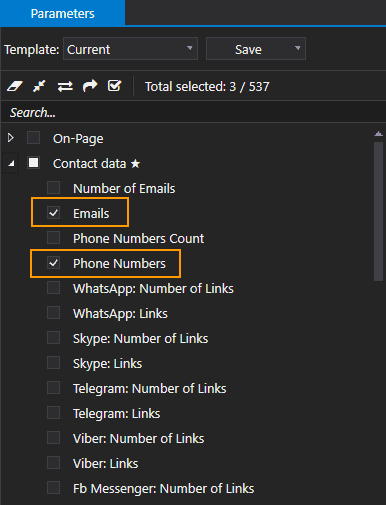
Step 4. Launch scanning.
Step 5. Proceed with it until the operation is done. You’ll see the data extracted in the separate table.
Step 6. Tab “Export” button and download the contacts to your file system.
Important: Netpeak Checker is compatible with Windows OS and Windows Server only. Also note that Netpeak Checker's contact data scraping feature is available only within the Pro Plan, which costs $264 per year.
Using GetProspect Cold Email Tool to Create Mailing Sequences
GetProspect cold email software is a powerful tool that you'll find useful in outbound email campaigns. With features like automated prospecting, personalized outreach, and detailed analytics, it empowers users to connect with potential clients efficiently.
Its mailing sequence feature can help you to improve overall cold outreach effectiveness. The sequence is built as a series of triggered messages sent based on the recipient's behavior or actions, such as subscription, registration, abandoned cart, ordering, and so on.
Follow a simple algorithm to create a mail sequence with Getprospect:
Step 1. Go to Contacts in your dashboard.
Step 2. Choose the contacts for which you’ll be creating a sequence.
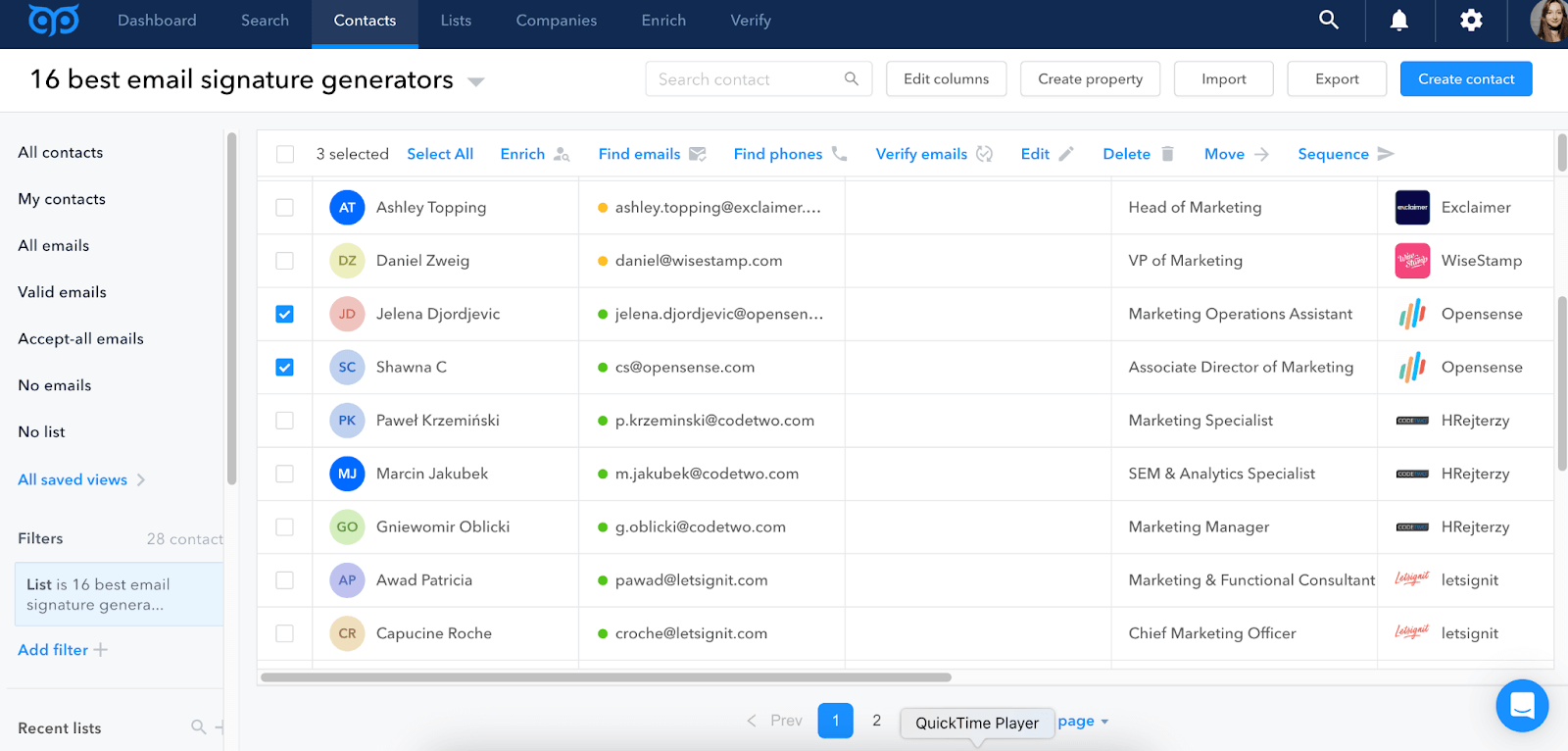
Step 3. Click the “Sequence” option in the top right corner, find the needed sequence, or create a new one and click the “Add leads” button.
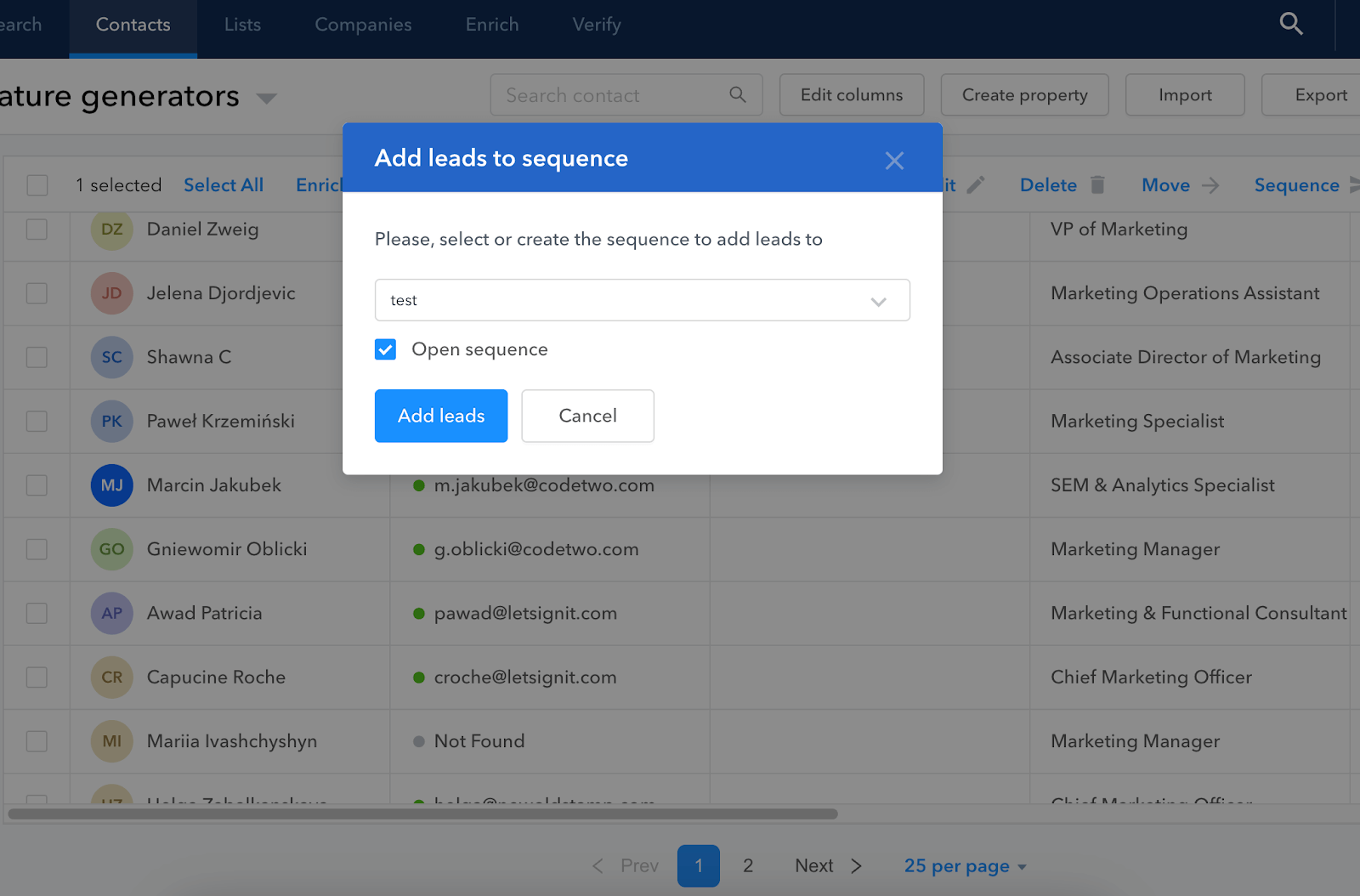
Step 4. Create one or several versions of your first letter. Send a test email to check everything works properly.
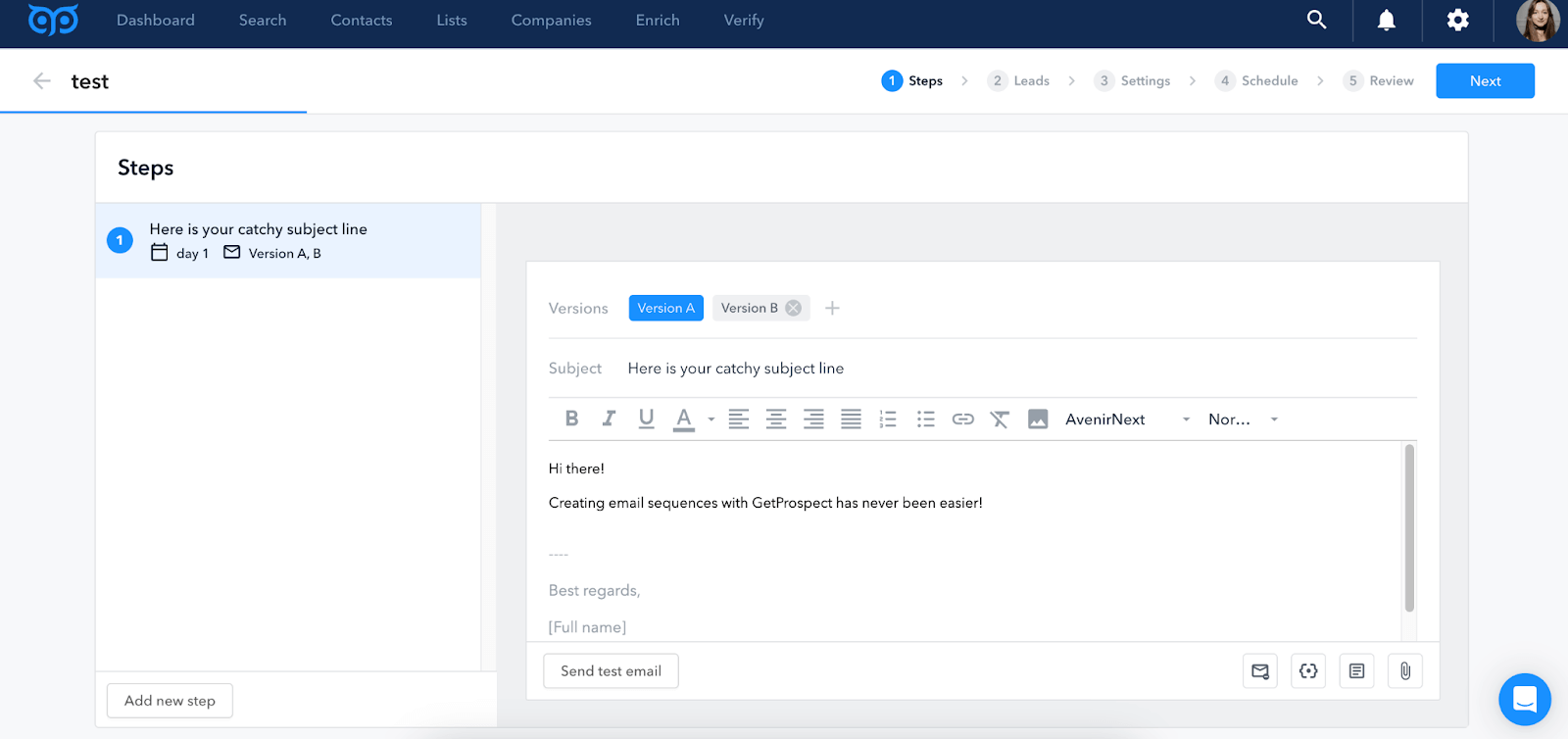
Step 5. Click the “Add new step” button in the bottom left corner to add a follow-up email. Also, define when it will be sent automatically by the system. In this example, we put follow-up after 7 days. The condition is “if no reply.”
You can add as many follow-up messages as you need.
When you create a series of emails, click the “Next” button in the top right corner and go straight to the Leads tab.
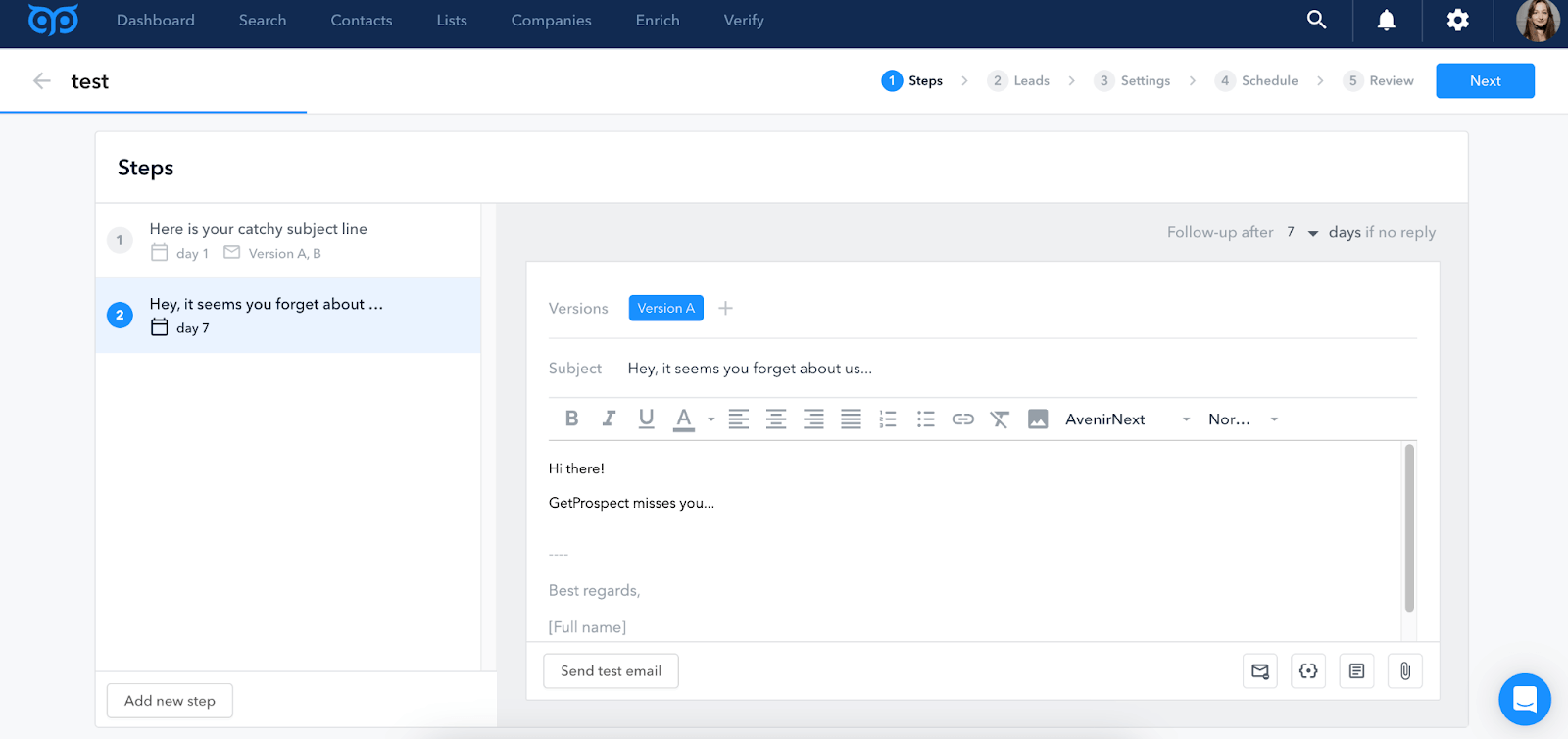
Step 6. At this point, you can recheck the list of leads, to add or remove some. After you are done, click “Next” again and go to the Settings tab.
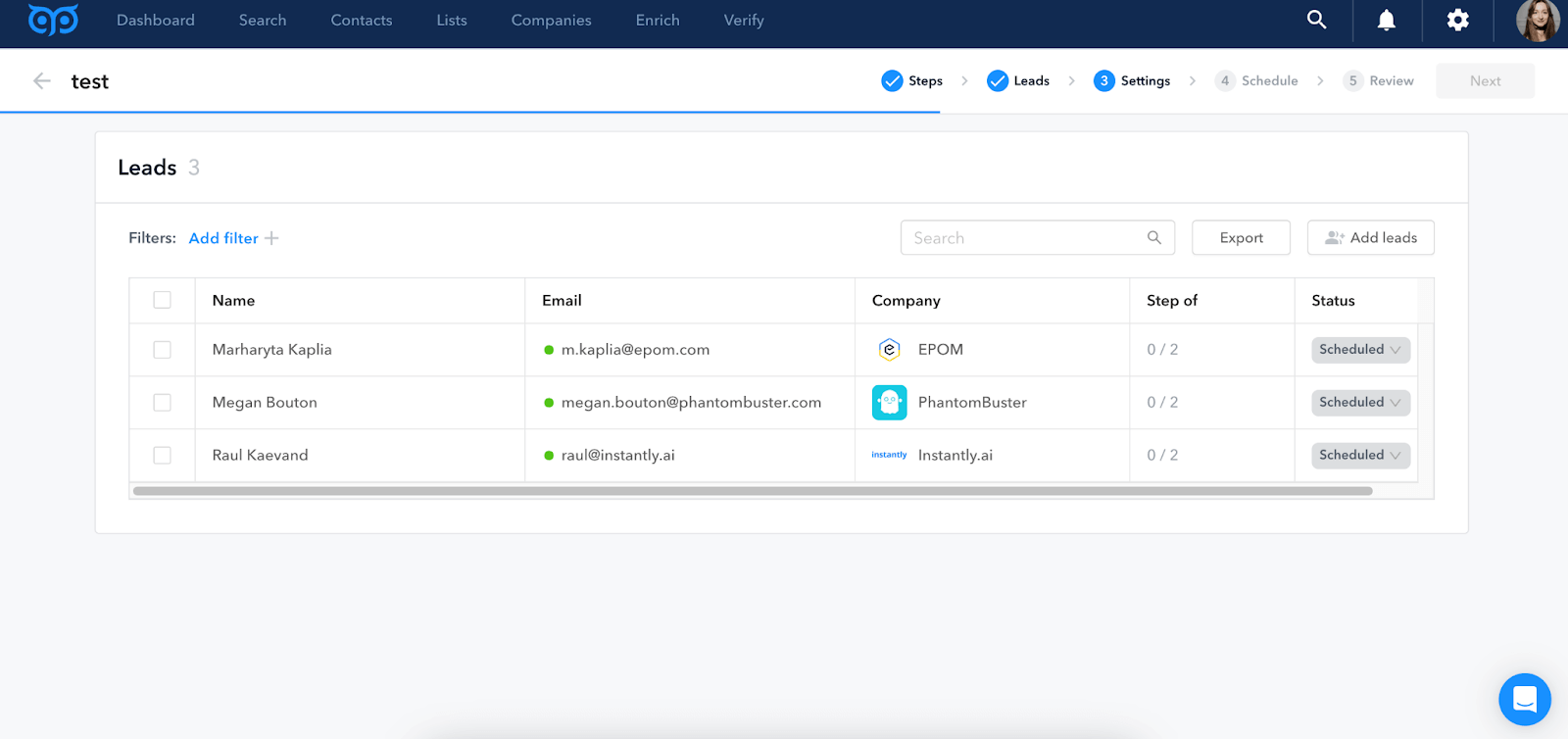
Step 7. Customize your sequence, set the limits of daily emails, specify the moment when the sequence will stop, define whether you’ll be tracking email opens or link clicks.
After you set everything up, click the “Next” button and proceed to the Schedule tab.
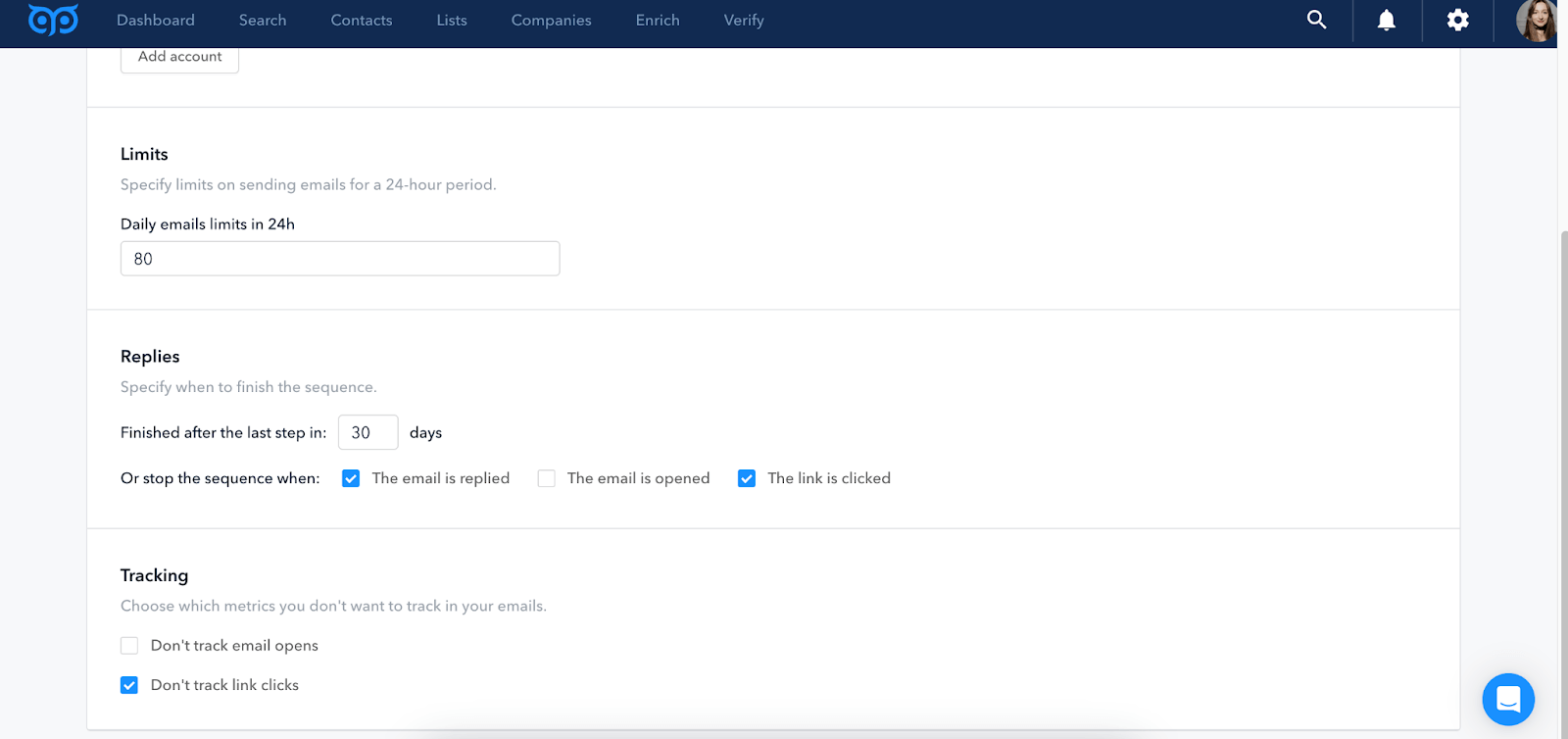
Step 8. At this point, you can set a precise schedule for your sequence. Define a time zone, set custom time and days for mailing, and press “Save schedule.” Then, click the “Next” button again. You’ll be landed onto the Review tab.
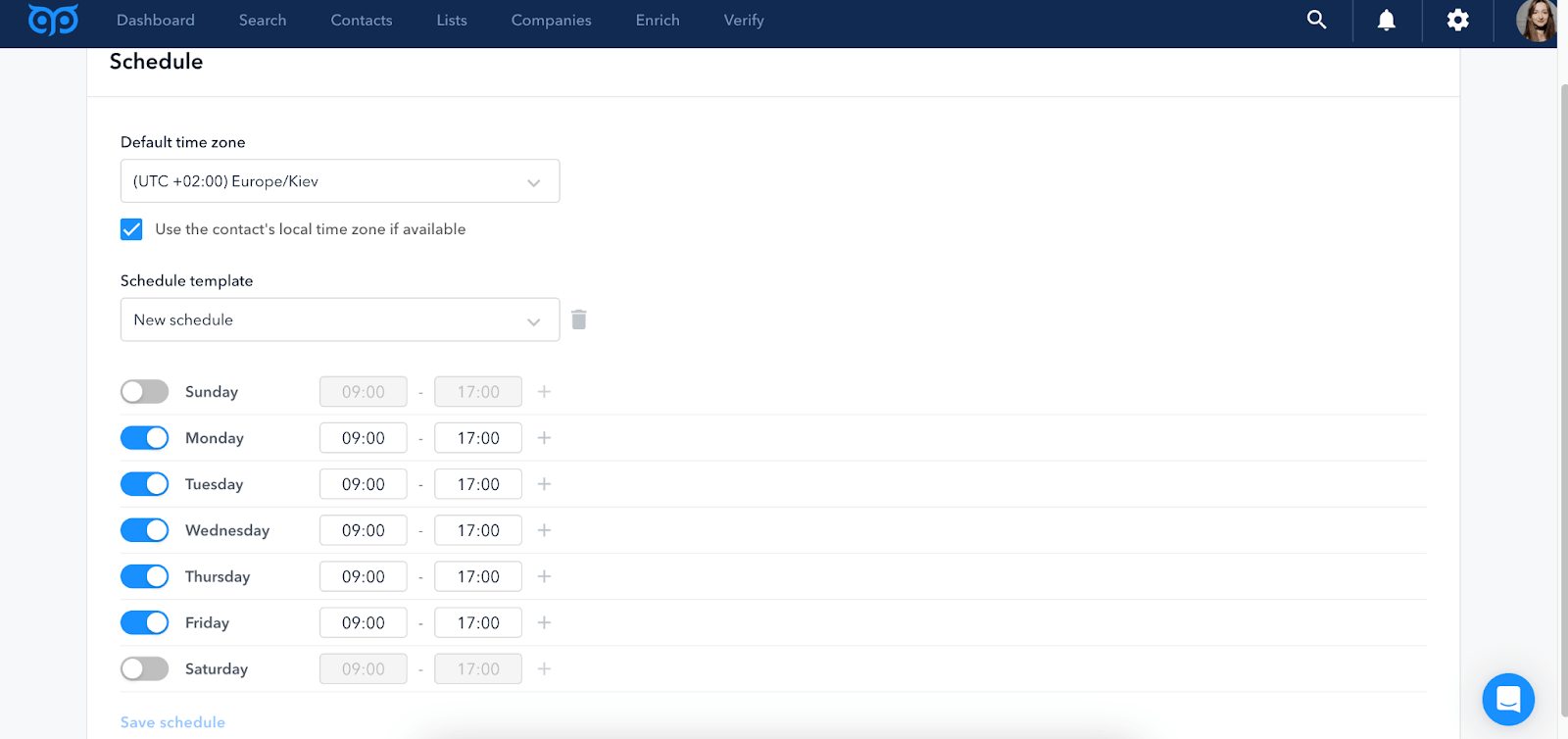
Step 9. At the Review stage, you have the possibility to recheck your sequence, update the mail body and signature, manage the recipients list (for example, remove some), etc. Also, here you can send a test campaign to make sure everything operates like it should. After review is done, press the “Launch” button. The sequence is initiated, congratulations!
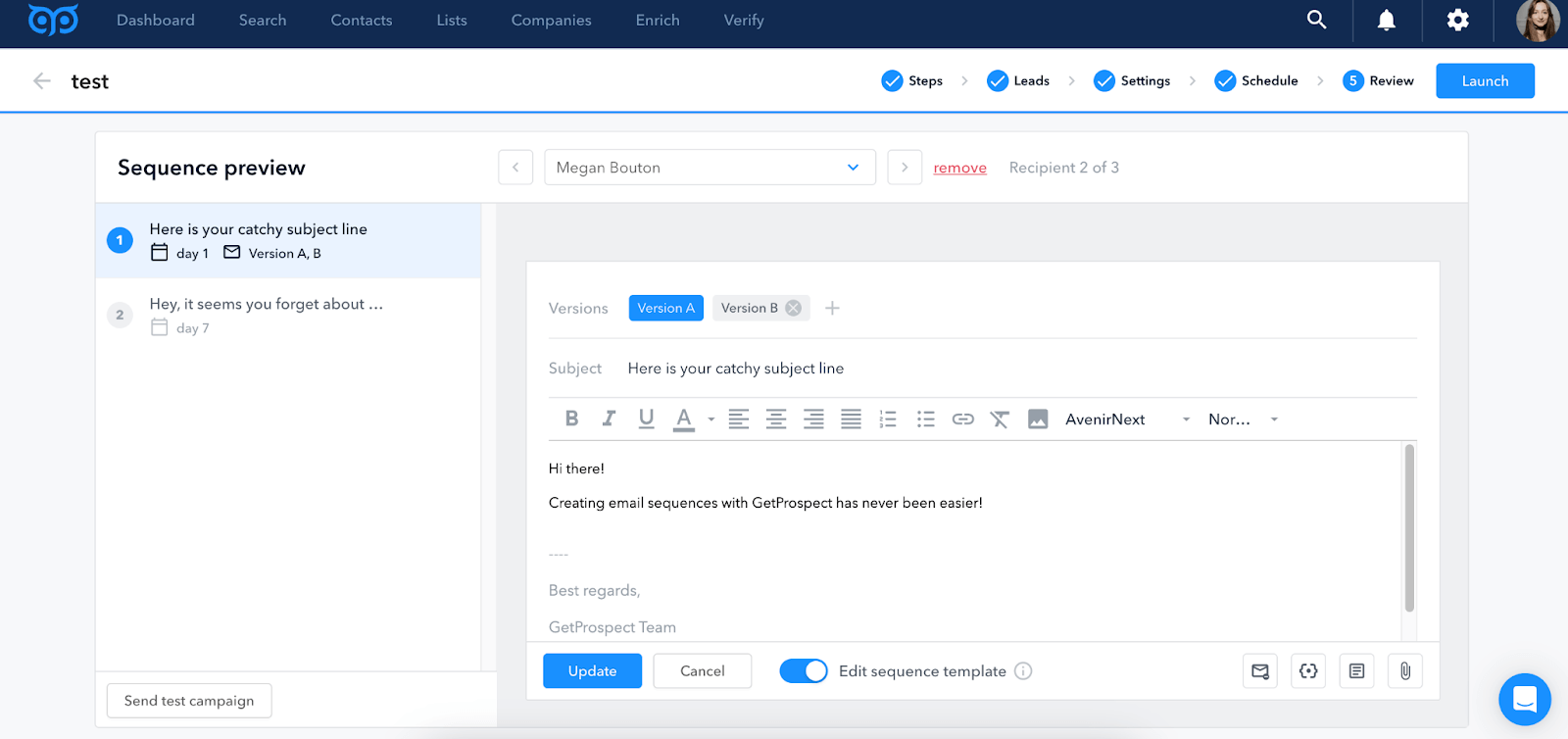
Cold Email vs Spam
Do you know the differences between an effective cold outreach campaign and mindless spam? Let’s cover them for you to navigate the fine line between ethical communication and annoying your potential collaborators:
- Personalization
Effective cold email outreach means tailoring your messages to your recipients' specific needs and interests. It means avoiding the situation in the screenshot below when the message feels generic and impersonal. By personalizing your cold emails, you'll increase your chances of getting a positive response.
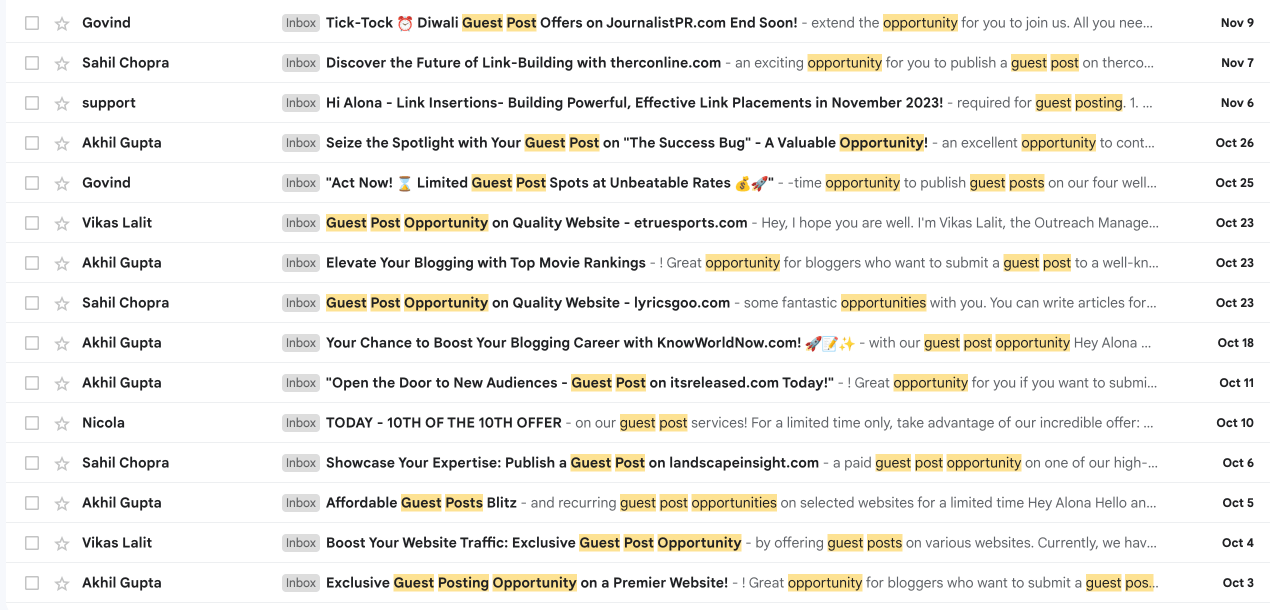
- Relevance
Best cold outreach emails always go beyond clicking send on a template. It's about taking the time to understand your recipient's interests, industry, and pain points. On the other hand, spam messages are notorious for their lack of relevance.
- Opt-Out Options Availability
Ethical communication is all about respecting boundaries. Legitimate cold email outreach provides recipients with clear and easily accessible options to opt-out or unsubscribe from further communication. Consider adding an unsubscribe option to your letter, like in the example below. It shows your respect your recipient.
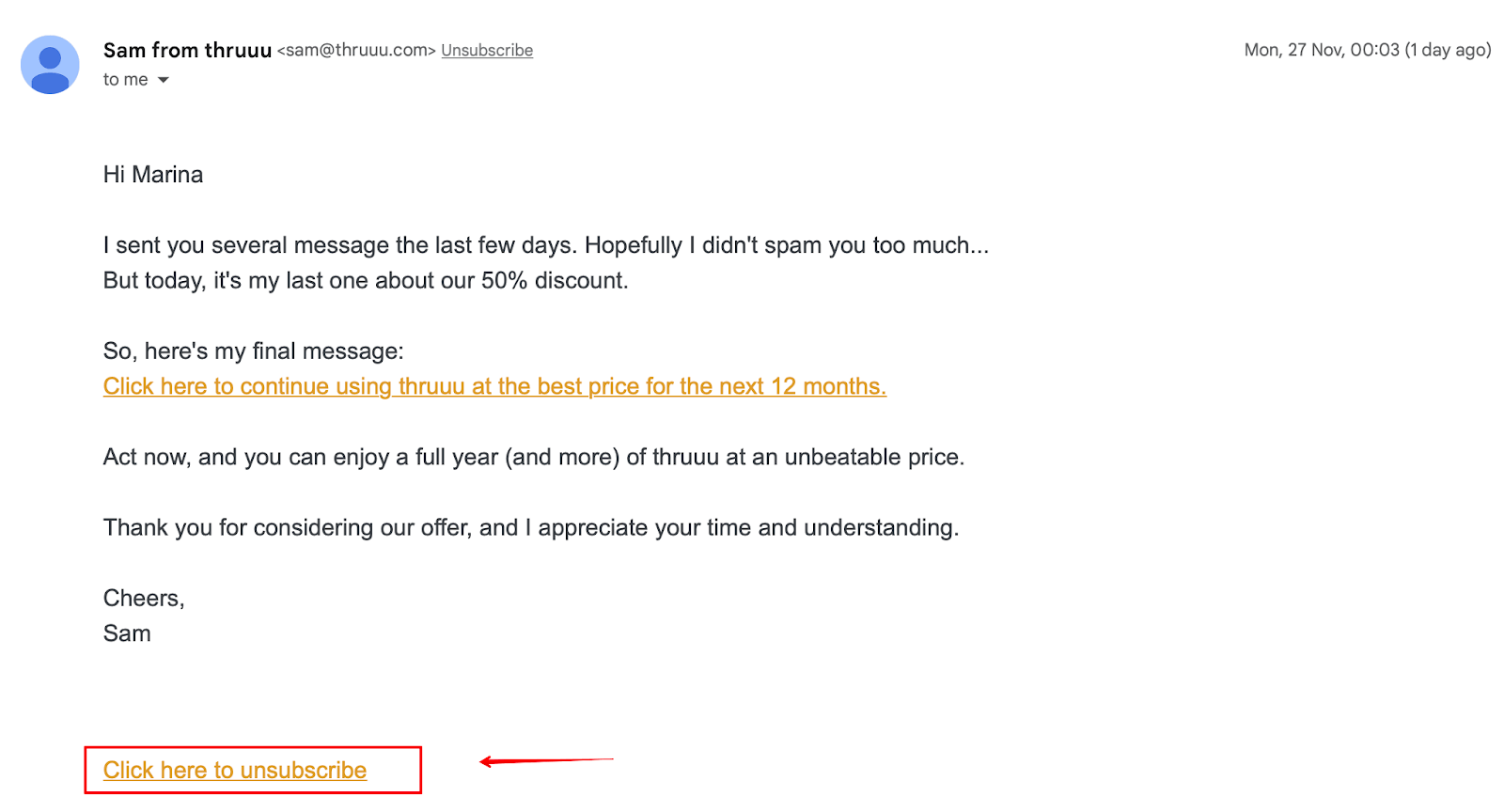
In contrast, spam disregards opt-out options, leading to frustration and a damaged sender reputation. Remember, respecting boundaries is not only ethical; it's also a smart business move.
Main Cold Email Strategies
- AIDA (Attention-Interest-Desire-Action)
- BAB (Before-After-Bridge)
- PAS (Problem-Agitate-Solve)
- MIP (Mention-Intrigue-Propel)
- 3P (Praise-Picture-Push)
Grabbing and holding recipients' attention is no easy feat. In the world of cold email pitches, several tried-and-true formulas can help you do just that.
AIDA (Attention-Interest-Desire-Action)
The AIDA formula is a powerful tool in cold outreach. Capture the recipients' attention, showcase the allure of your offering, intensify their desire, and conclude with a clear call to action.
BAB (Before-After-Bridge)
Humans are driven by the pursuit of pleasure and the desire to escape pain. The BAB formula taps into this primal instinct, highlighting the problem, vividly portraying life after the solution, and introducing your offer as the ultimate answer.
PAS (Problem-Agitate-Solve)
Empathy is a crucial element of effective persuasion. The PAS formula goes beyond merely addressing problems. It delves deeper — you step into the shoes of your recipient and agitate their pain points to amplify their desire for a solution.
MIP (Mention-Intrigue-Propel)
The MIP formula allows you to weave a compelling narrative, mentioning your competitors, intriguing recipients with the promise of something better, and propelling them towards your offer.
3P (Praise-Picture-Push)
Human beings respond to positivity, visualization, and a gentle nudge in the right direction. The 3P formula combines these elements to create a persuasive call to action.
Begin by demonstrating the prospects your praise and recognition for their achievements, making them feel valued and acknowledged. Then, skillfully paint a picture of how your offer can make their work better. Finally, with a gentle push, invite them to take the leap and join the collaboration.
When Should You Send a Cold Email?
Sending cold emails mid-week (Tuesday to Thursday) in the morning has been a long-standing recommendation, but let's take it a step further.
Try to aim for specific times within those windows. For instance, studies have shown that 10 AM on Tuesday can provide higher open rates, catching professionals when they have settled into their day.
Also, consider your prospects' time zones. Send emails during their working hours and thus grab their attention immediately.
Last but not least, send follow-up emails on Mondays and Tuesdays, as they get better open rates. Also, don't ever send cold outreach emails on weekends.
Final Thoughts and Key Takeaways
Writing a cold email requires a delicate balance between creativity, personalization, and professionalism. If you pay close attention to your subject line and incorporate a personal approach, you may significantly increase the success of your cold email outreach.
- Personalization is paramount — tailor your emails to the specific needs and interests of your audience, whether they are other SEOs, link builders, content creators, or PR/marketing specialists.
- Strategic timing matters — choose optimal time and days to send your cold emails, focus on mid-week mornings for higher open rates.
- Implement effective CTA — clearly state the desired action, making the CTA specific, actionable, and easy to follow.
- Follow-up strategically — implement a well-timed follow-up strategy, considering busy schedules and reiterating the value proposition in subsequent communications.
- Utilize tools for efficiency — leverage tools like Netpeak Checker for collecting personalized contacts and GetProspect for building effective email sequences.


